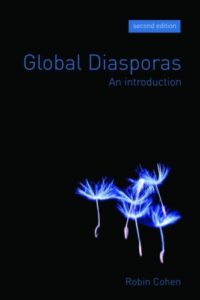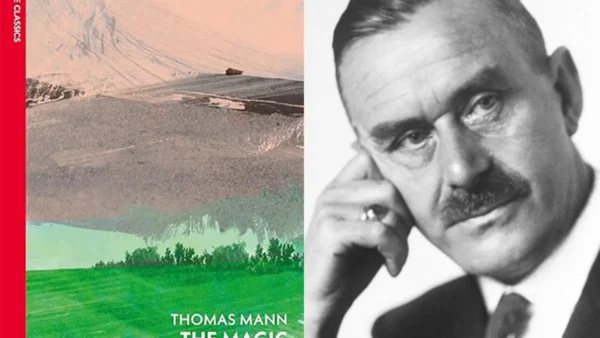Global Diasporas by Robin Cohen is an excellent introduction to the theory of diasporas, a term which has expanded considerably in recent years from its original use in the Jewish Diaspora to describe all kinds of cultural and ethnic dispersions. Cohen starts by defining common features of global diasporas:
- Dispersal from an original homeland, often traumatically, to two or more foreign regions;
- alternatively or additionally, the expansion from a homeland in search of work, in pursuit of trade or to further colonial ambitions;
- a collective memory and myth about the homeland, including its location, history, suffering and achievements;
- an idealization of the real or imagined ancestral home and a collective commitment to its maintenance, restoration, safety and prosperity, even to its creation;
- the frequent development of a return movement to the homeland that gains collective approbation even if many in the group are satisfied with only a vicarious relationship or intermittent visits to the homeland;
- a strong ethnic group consciousness sustained over a long time and based on a sense of distinctiveness, a common history, the transmission of a common cultural and religious heritage and the belief in a common fate;
- a troubled relationship with host societies, suggesting a lack of acceptance or the possibility that another calamity might befall the group;
- a sense of empathy and co-responsibility with co-ethnic members in other countries of settlement even where home has become more vestigial; and
- the possibility of a distinctive creative, enriching life in host countries with a tolerance for pluralism.
This is quite a comprehensive description, and although of course not every diaspora shares every trait, I think it is a very solid basis for analysing the different types of global diasporas:
- Victim diaspora, e.g. Jews, Africans, Armenians
- Labour diaspora, e.g. indentured Indians
- Imperial diaspora, e.g. British
- Trade diaspora, e.g. Lebanese, Chinese
- Deterritorialised diaspora, e.g. Caribbean peoples, Sindhis, Parsis
Cohen then analyses each type of diaspora in turn, starting with the original Jewish diaspora and showing, very interestingly, that it is not as simple a story as is often assumed. After the destruction of the Temple in 586BC, the key Jewish leaders were taken to Babylon in captivity, and Babylon after that became a codeword for exile and alienation for Jews and subsequently Africans. But Cohen points out that Babylon is where the embryonic Bible took shape, where the Talmud was written, where synagogues were formed. When some Jews began to return to Jerusalem and rebuild the Temple, the main centres of Jewish thought and culture were still in the communities at Alexandria, Antioch, Damascus, Asia Minor and Babylon. When the second Temple was destroyed in AD70, “it was Babylon that remained as the nerve- and brain-centre for Jewish life and thought.”
Cohen’s point is not to minimise Jewish suffering – he describes a lot of the anti-Semitism that Jews had to endure over the centuries in Europe and elsewhere, culminating in the horrors of the Holocaust – but to show that Jewish history, like the history of any people, is complex, a result of mixture and sharing ideas with other cultures. The imagery of the Jewish diaspora was in part shaped by Christians keen to position Jewish exile as a punishment for their part in killing Christ. But the reality is more complex, not a simple tale of victimhood.
The rest of Global Diasporas follows a similar pattern, as Cohen goes through examples of each type of diaspora, illustrating the characteristics listed above, and also emphasising the complexity that he established in the Jewish case. A common theme is the ambivalent relationship that many diasporic peoples have both to their host country and their homeland. The homeland is often remembered with fondness or longing, and the host country is often seen as intolerant or alienating; but also people may see opportunity in the new country and choose not to return to their homeland even when they are able to do so. The host country, after all, becomes home in a way, and exerts a lot of influence on people even as they retain allegiance to their older, ancestral home.
In the last few chapters, Cohen talks about diasporas in the context of globalisation. In a way, the more simple, nationalistic claims of diasporic groups are becoming increasingly anachronistic in a world where everybody is moving, where national boundaries are becoming less important than they once were. But using Cohen’s more complex analysis, in which diasporas are not isolated victim groups, but cultures formed as much by their contact with host countries as by their attachment to the homeland, it’s easy to see how diasporas fit into a “globalised” world. After all, people who move to another country in search of work rarely lose their attachment to their place of birth. Emigrants worldwide send billions of pounds back to support friends and family at home, and form their own networks in their countries of residence to maintain links with their culture. They also assimilate and absorb some ideas and practices from their hosts. Global Diasporas captured really well for me the fascinating ways in which human cultures are formed, both through historic and contemporary examples. We tend to think in simple, absolute categories of race, ethnicity and religion, but the reality that Cohen describes here is much more adaptive, collaborative, vibrant and, in the end, much more interesting.
If you enjoyed this review, please have a look at some of my other book reviews. Or sign up for my free monthly newsletter, which includes writing opportunities and other bonuses. It’s free to sign up, and you can unsubscribe at any time.





There are 8 comments
I use the the first chapter of this book as the foundation of the unit I teach in a general education class on Origins and Migrations as part of a Local to Global Theme. The key terms that Cohen introduces in the first chapter are essential to getting students to think about the issues involved and serve as a model to critique other examples of diaspora. I also use his article, “Diaspora, the Nation State and Globalisation” from Wang Gungwu’s edited work to analyze Cohen’s own model. Student’s start off very confused, but then start to get the point/counter-point approach in the 2 works.
I need to communicate with Dr4. Dorothea Martin. I lost contact with her. Cpould you please help me to get her email address. Thank yo0u.
I need to communicate with Dr. Dorothea Martin. I lost contact with her. Could you please help me to get her email address. Thank yo0u.
Thanks for visiting. I’m afraid I can’t give out people’s email addresses because I treat that as confidential information. But I have sent a message to Dr Martin drawing her attention to your comment, and if she recognises the name I’m sure she’ll be in touch. Hope this helps!
Very interesting review. Always thought of diaspora as a specific term for the Jewish experience – didn’t realise there were so many kinds. Thanks!
i intend to write my m.phil thesis on diaspora in Hanif Kureishi’s short stories… but m very much confused how to start and what to do ,,,, can anyone help me? plzzzzzzzzzzzzz
my comment is just to thank the scholars be course it has helped me during my course work